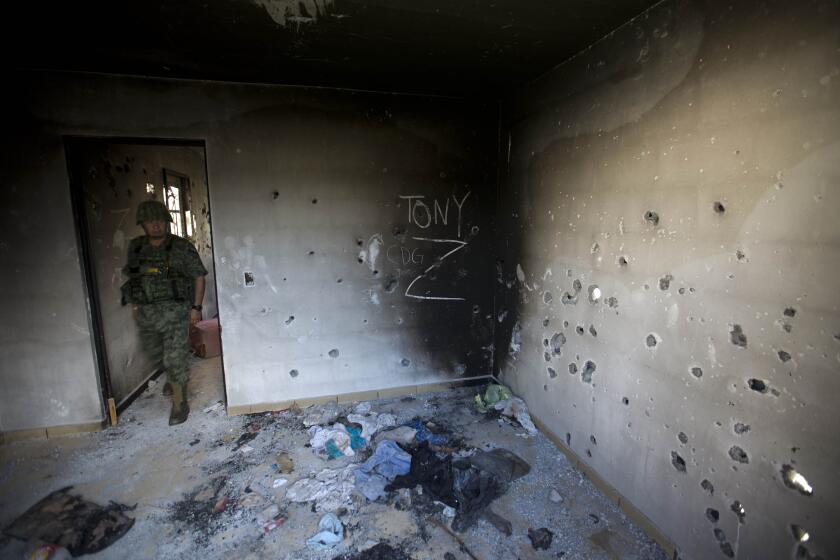St. Louis company strikes deal with Poland for isotope that is crucial to medical tests
As U.S. physicians face an impending crisis caused by lack of a crucial isotope used in many diagnostic procedures, a U.S. company said Wednesday that it had reached an agreement with the Polish nuclear energy agency to obtain the isotope from a reactor in that country.
FOR THE RECORD:
Medical isotopes: An article about medical isotopes in the Feb. 18 LATExtra section spelled the name of Polish nuclear physicist Maria Sklodowska as Maria Skladowsky. As the article noted, she was better known as Marie Curie. —
Covidien, a St. Louis company that processes a radioisotope produced by reactors into a form that can be used in the medical tests, said that Poland’s Institute of Atomic Energy will provide enough molybdenum-99 from the agency’s Maria Research Reactor to meet the needs of about 1 million patients annually.
That is not nearly enough of the isotope to replace the shortage resulting from the shutdown of the two primary reactors that produce the element, but experts said it is enough to allow radiologists to keep performing some tests rather than shutting down.
“This is only a short-term fix to a long-term problem,” said Robert W. Atcher, who heads a task force of SNM, formerly the Society of Nuclear Medicine, looking at ways to alleviate the shortage. The primary benefit of the new reactor may be for patients in Europe, he added in a statement.
Molybdenum-99 is a short-lived radioisotope that breaks down into technetium-99m (the m stands for metastable) -- the form that is used in medical tests. With a half-life of only six hours, the isotope allows physicians to examine blood flow and bones and identify tumors before quickly disappearing from the body, thereby minimizing radiation dose.
When supplies of technetium-99m are adequate, about 55,000 Americans every day and tens of thousands in the rest of the world undergo such tests. But the isotope is produced primarily in five reactors around the world, all of them over the age of 45 and none in the United States.
Canada’s National Research Universal reactor in Chalk River has been shut down since last May because of tritium leaks and other problems and is not expected to reopen before April. A second major reactor, in Petten, the Netherlands, will close Friday for four to six months of scheduled maintenance. The two reactors account for about two-thirds of the technetium-99m used in the United States.
A newer Australian reactor began producing some molybdenum-99 last year, but only in limited quantities.
Because the radioisotope decays so fast, it cannot be stockpiled. As a consequence, technicians are scheduling tests at all hours of the day and night whenever they receive a supply. Many are also resorting to older, less efficient tests that have seen only limited use in the last 20 years.
Covidien said a test run was conducted last week at the Maria reactor -- named after Polish nuclear physicist Maria Skladowsky, best known as Marie Curie -- and the product is now being processed into technetium-99m at one of Covidien’s European facilities. The company said it should begin distributing technetium-99m to European customers within 30 days.
But some complications remain. The company has to get permits from five countries to ship the molybdenum through them to its processing facility. The U.S. Food and Drug Administration must also test the finished product before it can be used in this country.
Meanwhile, the Obama administration has been funneling some stimulus funds into developing new ways to produce molybdenum-99.
The current procedure involves inserting a high-grade uranium target into a reactor for periods of about eight days. There, the uranium fissions into molybdenum-99 when struck by neutrons. After irradiation, the target is quickly processed to isolate the molybdenum-99, which is shipped to customers in a container that allows them to remove technetium-99m as it is formed.
Because high-grade uranium can also be used in nuclear weapons, the Obama administration and its predecessor have sought approaches that make use of low-grade uranium, which cannot.
Commercial nuclear reactors cannot generally be used to produce the isotope because they are sealed, so that targets cannot be inserted and removed.
GE Hitachi Nuclear Energy said last month, however, that some of its commercial reactors could potentially be used because they have a small opening that allows technicians to insert a probe to measure neutron flux inside the core.
The company is now performing experiments in which a low-grade uranium target is inserted instead of the probe to produce molybdenum. The company received $2.25 million in stimulus funds to develop the procedure and is using a similar amount of its own funds to develop the process, it said.
Reactor manufacturer Babcock & Wilcox has received $9 million in stimulus funds to develop a tiny reactor that is fueled by uranium in a liquid form. After the reactor has operated for a few days, the liquid would be drained into a container whose shape prevents a chain reaction from continuing. Once the molybdenum is removed, the uranium would be inserted back into the reactor.
Such a reactor could not be available for another two or three years at least.
Nuclear officials are also exploring ways to produce molybdenum-99 at a research reactor at the University of Missouri. That may be the best hope for near-term increases in supply, but it is not clear how soon product from there could be available.
More to Read
Sign up for Essential California
The most important California stories and recommendations in your inbox every morning.
You may occasionally receive promotional content from the Los Angeles Times.









